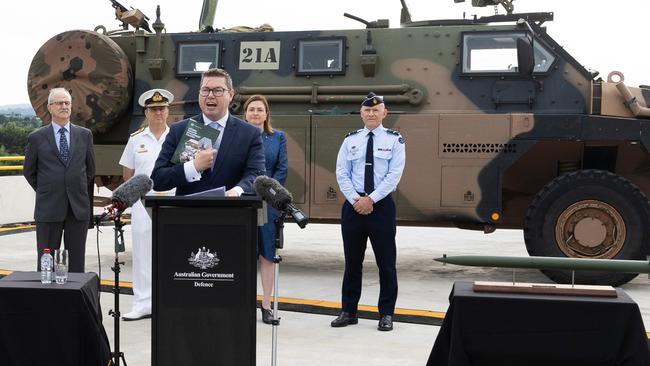AI testing signals leading-edge capabilities in robotic vehicles
Never before has a strong and sovereign innovation, science and technology sector been so important to our national security.

Last year at Cultana Training Area in South Australia, AUKUS Pillar II partners Australia, the United Kingdom and the United States achieved something remarkable.
In the toughest operating conditions, we demonstrated the integration of advanced autonomy and leading-edge Artificial Intelligence in robotic vehicles.
Australian defence scientists hit UK and US robotic ground vehicles and their supporting systems with everything in our electronic warfare armoury, including an electro-optical laser.
This cutting-edge AUKUS trial successfully tested the ability of autonomous vehicles to complete their missions and preserve network connectivity in a contested environment.
And in December, Deputy Prime Minister Richard Marles and his AUKUS counterparts committed to advance work to adopt resilient and autonomous AI technologies on land and in the water in 2024.
It is a signal of the incredible progress being made by Australian defence scientists on these leading-edge capabilities, especially through our AUKUS Advanced Capabilities partnership.
That progress is vital, because our technological edge is critical to Australia’s capacity to contribute to the maintenance of peace, security and prosperity in our region.
Never before has a strong and sovereign innovation, science and technology sector been so important to our national security.
The government’s new Defence Industry Development Strategy is backing the sector by, for the first time, clearly articulating defence priorities, simplifying procurement processes and providing targeted support to Australian industry.
The Defence Science and Technology ecosystem has been refocused around the priorities identified in the Defence Strategic Review to deliver asymmetric advantages in the shortest time possible.
The Advanced Strategic Capabilities Accelerator (ASCA) is key to the success of this effort.
Each mission will typically last three years and, once the technology is proven and affordable, the focus will be getting minimum viable capability into the hands of operators as soon as possible.
ASCA has an innovation incubation program that will rapidly adapt, test and acquire new or commercial solutions within a quicker time frame of one or two years.
ASCA has already released its first innovation incubation challenge, focused on the urgent need to acquire very small, general-purpose, Australian-made, uncrewed aerial systems (UAS) or drones.
This innovation incubation challenge has already made significant progress by bringing to light technologies available from Australian suppliers that were previously unknown to Defence.
And it demonstrates that government has Defence focused on speed: 11 companies have already signed contracts worth a total of $1.21m to provide prototypes for demonstration in April, along with production plans detailing how these companies could rapidly deliver their UAS solution at scale.
This is all part of the government’s strategy to bolster Australian industrial capability and locally produce our own drones for the ADF.
ASCA is also playing a key role in accelerating aspects of the advanced capabilities under AUKUS Pillar II.
ASCA will spearhead Australia’s participation in the innovation incubation program for the inaugural AUKUS innovation challenge focused on electronic warfare.
The government is making rapid progress on both developing and acquiring the next-generation technologies needed by the Australian Defence Force.
For example, for the first time in its history, the Royal Australian Navy has acquired underwater and surface vessels to detect, disarm and destroy sea mines.
More than $111m has been allocated to the project, generating up to 50 highly skilled jobs across Sydney, Melbourne, Launceston and Taree, in shipbuilding, robotic and autonomous systems integration, and project management.
In the pages of this report, you’ll see examples of the smart and agile partnerships between Defence, industry and universities that are essential to the future Australia’s national security.
And you’ll see some of the world-leading examples of the homegrown technologies that are transforming the Australian Defence Force.
There are many challenges ahead, but the government has delivered the funding, the strategy and the certainty to ensure that Australian innovation is at the forefront of ensuring the Australian Defence Force has the tools it needs to protect the security, interests and livelihoods of Australians.
-
Pat Conroy is the Defence Industry Minister and Minister for International Development and the Pacific.



